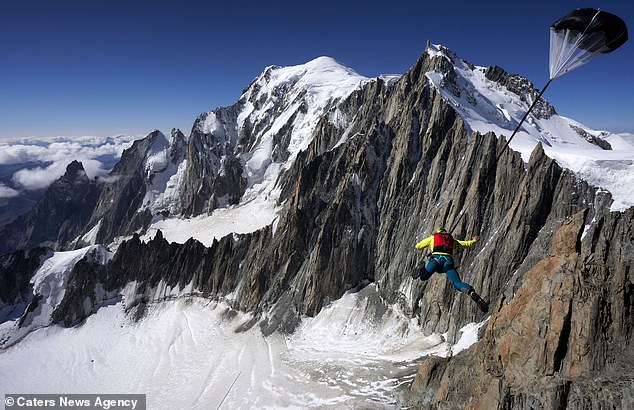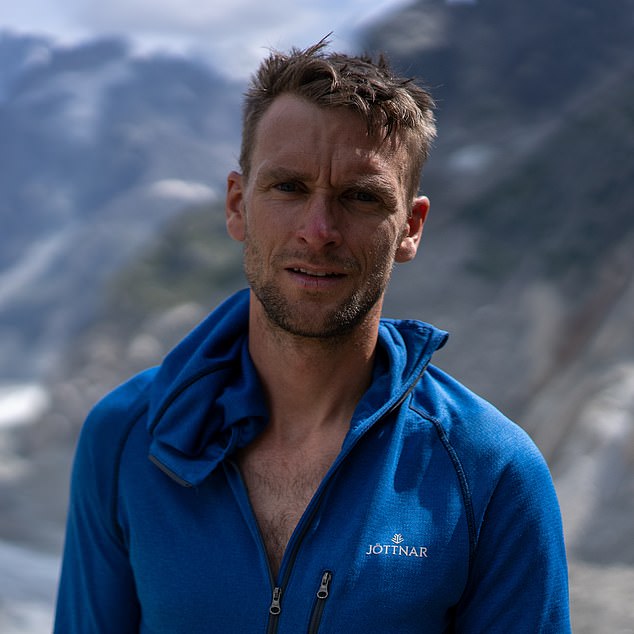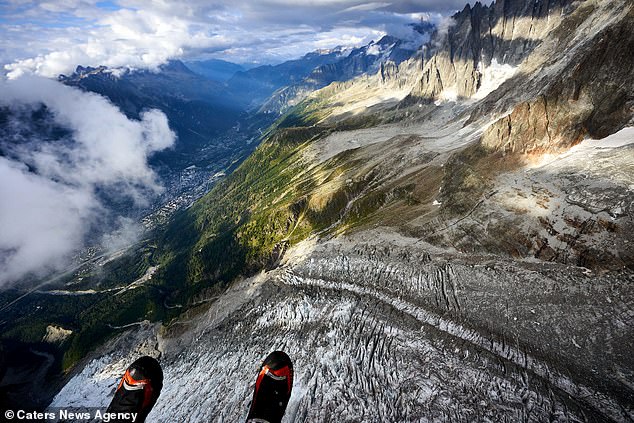MAIL SPORT EXTREME: Death-defying leaps of faith! But even after over 1,000 base jumps across 49 countries, perfectionist Tim Howell insists he’s still learning…
Calculated, not crazy. That’s how Tim Howell would describe the risks he takes when he base jumps off a mountaintop or skis off the edge of a snow-capped peak.
Howell has performed over 1,000 base jumps in 49 different countries, from heights of 20,000 feet. He can safely say that he does this not for the adrenaline rush, but more for the learning process and to test his skills.
A recent trip to Everest BASE Camp and Lhotse, a nearby peak near Mount Everest, where he had hoped to set a world record in base jumping by reaching speeds of about 260 km/h (160 mph) during his descent from the 8,200-meter (27,000-foot) highest peak, was canceled after he developed a cough and stomach pain.
Howell recovered to make the ascent, but as the air thinned, his body began to give out and he had to make the difficult decision to postpone his dream jump for the time being. If all goes well, he will attempt the jump next May.
Tim Howell jumps from Lord Berkeley’s Seat on the An Teallach Mountains in Scotland
“Honestly, the adrenaline only kicks in when something goes wrong,” he admits. “I tested it and found that my heart rate doesn’t go up at all on an average jump.
“Part of the appeal, for me, is how risky the sport is. The consequences are pretty big. So part of it is being able to train and make the right decisions, have the right mindset and learn the skills to mitigate that risk and make it as safe as possible for yourself.
“Ultimately, it’s all about decision-making. When accidents happen, 99 percent of the time it’s because you made the wrong decision.”
That “wrong decision” could have resulted in death or, at best, many broken bones. Fortunately, Howell has only had close calls, although he will never forget his first encounter with a wingsuit.

Howell jumps from the top of Mont Blanc – the highest peak in the Alps
“I’ve been jumping for about 10 years now,” he says. “Before that I was always a climber, a mountaineer, so a lot of the places I climbed, a lot of people jumped off.
‘The first time I saw someone wearing a wingsuit was when I was climbing a 1,000-metre cliff in Italy. We were halfway up the cliff and woke up to the sound of someone flying past us. It sounded like a jet engine and when I finished climbing I thought to myself, “It’s going to be a 12-hour walk back to the car, while this guy can be down in two minutes.” So it seemed like a logical step to take up base jumping. The wheels started turning and I realised this was the way forward.
“It’s hard to describe. When you fly a metre off a cliff, it’s not far from an incident, but you’ve done it on purpose. So there have been a few times where I’ve flown really close, really fast, to things and you can be a fraction of a second or an inch away from something going wrong.
‘A few hundred jumps ago, my canopy on my parachute deployed incorrectly. I managed to turn it around in time and that is thanks to all the skills and drills we practice to get out of those situations.
“But apart from that, there are no injuries.”
And so the wheels kept turning. Howell has always been one to push the boundaries and climb cliffs all over the world, but this new challenge of diving off a peak, not just out of a plane, was something that was extra appealing.

Howell says it’s the danger and risks involved in BASE jumping that appeal to him
Before he could begin his wingsuiting adventure, Howell discovered that you need to have experience skydiving. It was an extra string to his bow.
“I’ve climbed a lot all over the world and I’ve seen someone base jumping in Thailand once, without a wingsuit. I helped them get to the exit and then I had just started skydiving. That was hundreds of skydives away from where they were base jumping,” he says.
‘You have to have experience with skydiving before you start base jumping, and I knew that. So I started skydiving with the goal of becoming a base jumper.
‘It took me two years to make 200 jumps. I started on my 21st birthday, and on my 23rd birthday I found someone to teach me how to base jump.
‘I lived in South Africa for a few years. I was in the army, so I’ve seen the world. I live in Geneva now, but I travel all over the world looking for things to climb on and jump off of.’
Howell admits he grew up idolizing JT Holmes and Shane McConkey, two skiers who took their sport to an even more extreme level by adding base jumping. The sad case of McConkey, who died after one of his skis failed to release during a jump in the Dolomites, serves as a reminder of how dangerous the sport can be.
Before he could hit the slopes, Howell built a series of bridges, cliffs and even antennas.

Howell’s view from the top of Mont Blanc, just before he made his amazing jump
“I’ve always been a skier, certainly longer than I’ve ever been a climber,” Howell says.
“I grew up watching Holmes and McConkey. They started with base jumping and then took it to their sport, combining multiple disciples, so I thought that would be a cool thing to do.”
Howell is only 34 years old, but he foresees many more leaps ahead.
He recently checked off Norway, where about 100 base jumpers gathered in the Scandinavian fjords. A helicopter was used to transport the jumpers to the jump site at Kjerag, on the outskirts of the town of Lysebotn.
“I’ve been to 49 countries now,” Howell says. “My favorite is probably Greenland.
“But we are planning a Christmas trip now and we are looking at all sorts of options, including Hawaii, French Polynesia, Reunion, Madagascar. It’s about thinking outside the box and going to countries that are less visited than many European countries.”
■ Click here to visit the Scotland homepage for the latest news and sport features.
